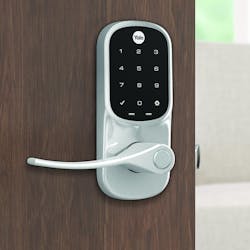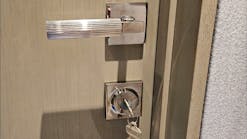Residential security has seen swift changes over the past 10 years, especially with the surge in smart home products, services and options. From smart doorbells and locks to thermostats and blinds to gates and garage doors – you name it and there is a smart sensor for it connected to an app or network.
Fortunately for residential security professionals, the focus is returning to the door, as more homeowners – and multifamily property owners – are looking to add convenience to the simple function of granting, or not granting permission, from wherever, in addition to seeing and communicating with anyone at the door.
Looking at the latest Parks Associates’ research, between 9- and 11-percent of U.S. internet households, or more than 12 million households, own a smart door lock, nearly double the adoption rate five years prior. Following a dip in 2020, smart lock purchase intention has returned to pre-pandemic levels.
“Although purchase rates have remained consistent, purchase intention decreased during 2020, corresponding to the COVID-19 pandemic and the downturn of economic activity that came with it,” Parks Associates President and CMO Elizabeth Parks tells Locksmith Ledger, noting that although purchase intention has rebounded since 2020, “there is still a considerable discrepancy between purchase intention and actual purchase rates, indicating that there are factors inhibiting actual purchase.”
She continues, “Both current smart device owners and non-owners display intentions to purchase a smart door lock, but households owning smart home devices already have intentions nearly three times those of households without any smart home devices.”
According to Parks Associates’ consumer data based on smart home device owners, 28 percent responded that they are very likely to purchase a smart lock, while 8 percent of non-smart home device owners reported that they are “very likely” to purchase. “Smart home device owners understand the value of these kinds of devices more than non-owners,” adds Parks.
Consumer reported market share among smart door lock manufacturers has remained consistent for the most part since Q4 2020, according to the research firm, with Google Nest and Yale continuing to be the “pre-eminent brand (s) in the space, making up just over a fifth of overall market share,” says Parks. “Brinks and SimpliSafe have remained the next biggest brand (s) with market shares just above 10 percent. August and Baldwin have both had their market share fall compared to record highs in 2020.”
When it comes to connecting locks and access control to the entire smart home ecosystem, affordability, smart phone interoperability, privacy and quality top the list of important factors for lock brand, according to the latest Parks Associates’ data. “Affordability is the biggest factor influencing smart door lock brand and purchase,” notes Parks. “Like other connected devices, perceived value is paramount to consumers. However, privacy and data security are also very important, with 27 percent of door lock owners in Q4 2021 indicated that they made their purchase based on what brand they trusted most to keep data secure.”
Keypads a Must-Have Feature for Smart Locks
As the smart home and smart lock gain prominence, 47 percent of households that plan to purchase a smart lock indicate a keypad is a must-have feature.
“Convenience is the driver behind the keypad,” notes Parks. “Despite the popularity of keyless and touch entry, users indicate that maintaining a traditional key option is still important for smart locks. Nearly 40 percent of all smart lock owners indicate that their lock’s keypad is a useful feature for guest access needs such as housekeeping visits, package deliveries, and visits from friends.”
While user codes and other forms of keyless entry are prominent features of smart door locks, “homeowners can assign codes to individuals both inside and outside of the household, and records of those codes can be stored in the accompanying mobile app,” Parks explains. “Having a record of codes and when they are used provides a clear picture of who is coming in and out of the house. This, in turn, improves automation and security options. Housekeepers, guests, babysitters and others can all be given temporary codes that get them conveniently in and out of the home but are also kept track of.”
She adds that other must have features for smart locks include safety and security features including open door alerts, tamper alert, and video integration, noting, “Also, the keypad, use of app to unlock, and even traditional keys are top features consumers want.”
Multifamily Space a Big Opportunity
Multifamily or multi-dwelling units (MDUs) are an area of strong growth, with about three out of four MDU property managers finding the ability of smart door locks to minimize key replacement costs “very appealing,” according to the latest Parks research. In a recent white paper, Smart Locks and Access Control Supply Chain: Scaling Innovation, which Parks did in partnership with PassiveBolt, researchers found that while most residential door locks installed in the U.S. are mechanical, “an increasing number of exterior locks in single-family homes are being replaced with smart door locks. Across single-family, multi-family, retail, and commercial spaces, builders and owners are adopting connected entry solutions to create more secure and functional spaces.”
Smart door locks and associated whole-building access control systems, they found, have fueled the recent acceleration in smart apartment adoption while several major production builders now include them in standard specifications. Feature innovations, such as biometric verification, integrated video cameras, voice control via smart speakers, and integration with home delivery services, help to “raise awareness and value perceptions of smart door locks,” researchers noted, adding that increased awareness “triggers sales in retail, security, home builder, and system integrator channels.”
MDU owners/operators value smart access control for security, convenience, and OPEX savings, they said, as properties want to grant access to units remotely for unaccompanied viewing, assist with package delivery, control who had access to units, and make key replacement more efficient. Some key data points:
- 73% of MDU properties with smart door locks use the devices to grant access to units remotely for unaccompanied viewings, package delivery, or third-party services.
- 65% use the locks to track who enters and leaves the property using temporary, unique access codes.
- About three out of four MDU property managers find the ability of smart door locks to minimize key replacement costs “very appealing.”
- One-third of MDU property managers report that their residents are demanding the ability to enable remote access to apartment units.
Safety and security remain the leading purchase drivers of smart home devices. Smart door locks and smart access control systems provide a foundation of security by helping consumers and building owners/operators monitor and secure the primary access points. Typical use cases for smart door lock and access control systems:
- Grant entrance access remotely.
- Receive electronic real-time notifications of who is entering and leaving.
- Assign permanent and temporary virtual key with access schedules for specific days and times.
- Change or revoke access privileges at any time.
- Trigger tamper and forced entry alarms that warn of a possible break-in.
At its 27th annual CONNECTIONS Conference in May, Parks Associates released the white paper "Gating Access: Challenges in Multifamily Properties," in partnership with research sponsor Nimbio, analyzing the current state of access control adoption in the U.S. multifamily housing market. At least 70 percent of multifamily property managers and owners are interested in each of the top four use cases for smart door locks that were presented, with solutions that appeal to both residents and management. Currently, 11 percent of MDU residents live in a building with smart locks or an access control system, and these results indicate significant market opportunities for access control deployments and retrofits.
“Multifamily properties are increasingly adopting access control technology to ensure that only authorized persons can enter the property,” says Kristen Hanich, research director, Parks Associates, and author of the white paper. “Access control systems offer a wide range of benefits, including increased operational efficiency, reduced labor costs, and improved safety and security for residents.”
The white paper reveals that access control technology is more commonly adopted in communities that charge higher monthly rents. However, the adoption of these solutions is expected to increase as the business case for deploying access control technology continues to evolve. The research provides insights into access control, smart locks, and smart gating solutions, including use cases, deployment models, best practices, and priorities when retrofitting.
Networked Cameras and Smart Doorbells Still Hot
Networked cameras and smart video doorbells will see continued steady growth, with each device category reaching 17% adoption among U.S. internet households at the end of 2022, and combined, they will exceed $3.8 billion in sales revenue by 2027, according to Parks research just released this month.
The research firm notes that quarterly consumer surveys indicate networked cameras and smart video doorbells will continue steady growth due to persistent popularity and clear security use cases. Parks forecasts that close to 30 million U.S. internet households will have a video doorbell or smart cameras by 2027. The firm’s consumer data, including quarterly surveys of 10,000 U.S. internet households, shows that 57 percent of video doorbell owners report safety and security as a factor for purchasing the device. Thirty percent of internet household report plans to purchase one of these devices within the next year.
"Video devices continue to see sustained growth, even in a tough economy,” says Jennifer Kent, VP, research, Parks Associates. “Due to consumer interest and intense competition in the space, smart cameras are rapidly improving in quality and features, and their advanced AI features enable new use cases and revenue opportunities."
In addition, Parks Associates finds 7 percent of U.S. internet households have solar power generation, 41 percent have a smart home device, 55 percent have a smart TV, 51 percent have a smart speaker, and 25 percent have professional monitored security services.
AI Increases Value Proposition
Interestingly, Parks research found that Artificial Intelligence (AI), including face recognition, can be a key differentiator for smart home providers by their enhancing safety, convenience, and personalized value propositions, with 86 percent of consumers reporting at least one AI feature as important to their purchase decision for a smart video doorbell or camera.
“Face recognition creates operational savings for security monitoring, reduces the time and effort to validate the security event, and provides verification data to first responders to reduce response times and fines for false alerts,” Parks says.
While consumers are interested in new technologies like AI, 26 percent said that data concerns could be an impediment to adoption. Parks notes that consumers are concerned not only about unauthorized access by hackers and bad actors but also how the product and services companies are storing and using their data.
“Face recognition technology is poised to expand beyond home security and will also cater to other verticals,” notes Parks. “Our research shows only 37 percent of consumers trust the companies that have access to their personal data, so industry players will have to address increasing concerns over privacy and data security concurrently, as they integrate these new capabilities into their solutions.”
Paul Ragusa | Senior Editor
Paul Ragusa is senior editor for Locksmith Ledger. He has worked as an editor in the security industry for nearly 10 years. He can be reached at [email protected].






